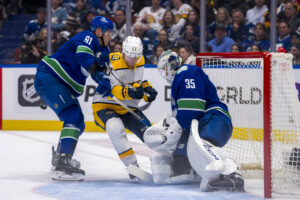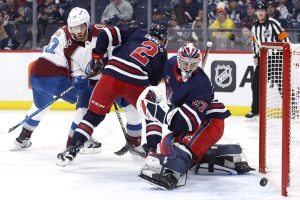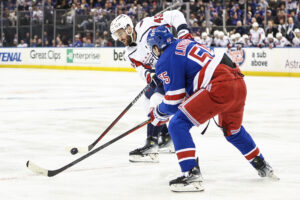Nearly four years ago to the day, on May 25th, 2016, Vancouver Canucks management swung for the fences, acquiring rugged defenceman Erik Gudbranson and a 2016 fifth-round pick from the Florida Panthers. They paid a pretty penny, parting ways with promising centerman Jared McCann, a 2016 second-round pick, and a 2016 fourth-round pick.
A Look Back at the Erik Gudbranson Trade
It was clear that the Canucks rebuild was well past overdue, and trading the assets they did was taking multiple steps in the wrong direction. Clear to everyone but the management and ownership, that is. At the time, they seemingly had an allergic reaction to the word “Rebuild,” opting instead to commit to a so-called “Retool on the fly.” The plan was to “bridge the gap” between the youth and the veterans, by acquiring players in or near their prime to create insulation. Erik Gudbranson was one such player.
The Expectations, and the Reality
The expectation was that Erik Gudbranson could slot in on the second pairing with Ben Hutton, and provide a reliable, physical presence on the blueline. Some thought there was some offensive potential to be tapped into as well, although that was never his forte. It seems that Jim Benning was one of those people, saying “He can move the puck, and he kind of came into his own this year in Florida… He can make a good first pass, he has a really hard shot, he can hammer it from the back end,” in an interview at the time of the trade.
Long story short, “Guddy” never came close to meeting those expectations. He was simply abysmal on the ice for the Vancouver Canucks. The opposition shelled the defensive defenseman in his zone night after night. His Corsi and Fenwick were underwhelming at best, at 44.4 percent and 43.9 percent, respectively. His RAPM charts only add to the disappointment, with negative z-scores across the board. Below are his even strength and power-play RAPM charts, from 2016 to 2019. The overwhelming majority of this chart is based on his time with Vancouver.

He never found his offensive game either, scoring only 19 points in his 139 games with the team. Gudbranson did have the added disadvantage of playing on a disastrous Canucks team for most of his tenure, but the fact that he failed to come remotely close to his expectations remains much the same.
Where is Gudbranson now?
In arguably his greatest trade with the Canucks, Jim Benning traded Gudbranson to the Pittsburgh Penguins at the 2019 trade deadline in exchange for Tanner Pearson. Pearson’s time with the team Canucks has been wildly successful, setting a new career-high of 45 points in this shortened season, and it seems as though he’s found a home playing alongside Bo Horvat. Gudbranson has since found a role of his own with the Anaheim Ducks, in which he’s played surprisingly well. In his new role, both his Corsi and Fenwick are above 50%, and his scoring rate was easily the highest of his career, with four goals and nine points in just 44 games. With one year remaining on his contract, he should be in consideration for a full-time role with the Ducks next season.
Jared McCann
McCann was just coming off his rookie season when the Panthers acquired him. Nine goals and 18 points weren’t exactly eye-popping, they were completely respectable from a 19-year-old center playing limited minutes. It was clear he had the potential to be a reliable contributor at the NHL level. Become a reliable contributor, he did. In 143 games with the Panthers, McCann scored 53 points before they traded him to none other than the Pittsburgh Penguins, the unofficial 3rd team involved in the Erik Gudbranson deal. With injuries to both Sidney Crosby and Evgeni Malkin, McCann saw increased offensive opportunities and he took full advantage of it, scoring 35 points in 66 games. Both the eye test and analytics are promising for the young forward, who should continue to be an impactful player.
The Draft Picks
Of the three draft picks exchanged in the trade, only one has become a player that’s seen NHL action. Vancouver’s second-round pick made its way to the Buffalo Sabres, who drafted Rasmus Asplund with the selection. Earning a call-up in November, Asplund played in 29 NHL games, putting up 1 goal and 3 points. While the numbers weren’t impressive, the Sabres kept Asplund in the NHL until mid-January. It’s expected that he will remain in competition for an NHL spot next season.
With Vancouver’s fourth-round pick, the Florida Panthers drafted a Center, Jonathan Ang. He just completed a respectable sophomore season in the AHL, scoring 21 points in 49 games. The numbers aren’t impressive, but Ang never was a high scoring player. While it remains unclear whether or not he will ever make the NHL full time, he’s turned himself into a viable call-up option for the Panthers.
With Florida’s fifth-round pick, the Vancouver Canucks selected Cole Candella. There’s not much to say about Candella, a prospect that the team never signed to an ELC. After completing his final Junior season, he signed in Denmark, where he will look to further his professional career.
Final Words
It was clear that the Gudbranson trade had the potential to be a disaster for the Vancouver Canucks. In fact, it was a disaster for some three seasons. However, it turned out to be okay when it was all said and done. The Canucks front office did an impressive job of recuperating value from the deal. Did the Canucks receive full value for their assets? No, but the trade tree certainly could have ended up worse for them.
Main Photo:
Embed from Getty Images






